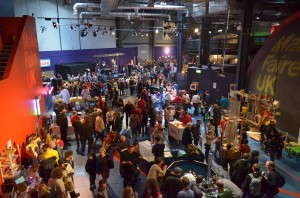
There’s an exciting phenomenon taking place,defying the stereotypical image of ourselves glued to a TV screen. It may be too soon to say if the popularity of ‘making’ is going to be a transient, low-burn movement. But when the venture capitalists start to jump in, it’s usually a sign that something significant is happening. And the VCs are taking a growing interest in the maker movement.
I spent a fascinating day at ‘Maker Faire UK’ yesterday. (The spelling of ‘Faire’ is intentional: as in the French verb to make or do). It was big, and attended by a wide demographic: babies, kids, geeks, hipsters, boffins and old people like myself. Exhibitors showed off their pet projects, and they ranged from the cutting-edge (3D self assembly printers for under £500, bio tech ‘hackers’ La Paillasse) to the whimsical (a robotic woman who knits perfectly) and slightly disturbing (pole dancing female robots, anyone?)
 There are three striking aspects of the maker movement. The first is the way in which crafting is meeting coding, and allowing for spectacular results. There was a time when artists and coders inhabited two separate universes – no longer. I saw drawing, ceramics, even crocheting being pushed forward through some kind of connection to a computer. At the heart of many of these inventions is the ‘arduino‘: a simple, single board micro controller. The uses to which the arduino is being put, are astonishing. Many, like the ‘romance pants‘, (you have to see it to believe it) are typical of the irreverence that typifies this hacker community. But I also met a young woman who was working on a tool for a young person suffering from autism: a sensor built into a pendant that would vibrate to tell her that she was invading someone’s body space.
There are three striking aspects of the maker movement. The first is the way in which crafting is meeting coding, and allowing for spectacular results. There was a time when artists and coders inhabited two separate universes – no longer. I saw drawing, ceramics, even crocheting being pushed forward through some kind of connection to a computer. At the heart of many of these inventions is the ‘arduino‘: a simple, single board micro controller. The uses to which the arduino is being put, are astonishing. Many, like the ‘romance pants‘, (you have to see it to believe it) are typical of the irreverence that typifies this hacker community. But I also met a young woman who was working on a tool for a young person suffering from autism: a sensor built into a pendant that would vibrate to tell her that she was invading someone’s body space.
The second is even more telling. It’s almost impossible to be part of the maker movement and not subscribe to ‘open source’ principles. This is open learning at its most exciting. Every exhibitor seemed to have made their projects freely accessible . Enterprises like How Do are springing up to make sure that learning is open, social, immediate, and fun. There’s a generosity at play in the maker movement that’s inspiring in all senses of the word
The third thing that hits you about a Maker Faire is seeing so many young people deeply engaged, using their hands – and their heads – to learn about, and make, stuff. Whether soldering, shrimping (making arduinos from scratch) or throwing pots, their absorption was actually quite moving. I spoke to a mother of a girl who was studying coding at school. She lamented the fact that, while programming was considered to be useful, soldering circuit boards, which turns code into machines, wasn’t encouraged. Learning by doing is still the port relation of learning by knowing, or learning by remembering.
I was hoping to see a school party of kids at the Maker Faire, but I didn’t spot any. It’s a real shame, because the learning that is evident from any of these projects would convert even the most determined opponent of project-based learning.
No matter. This is a movement that is growing fast, and hopefully more schools will attend Maker Faire 2014. In the meantime, here’s how to turn your school into a Makerspace, and a ton of ideas from the Make Forum, any of which would make for a great project.
